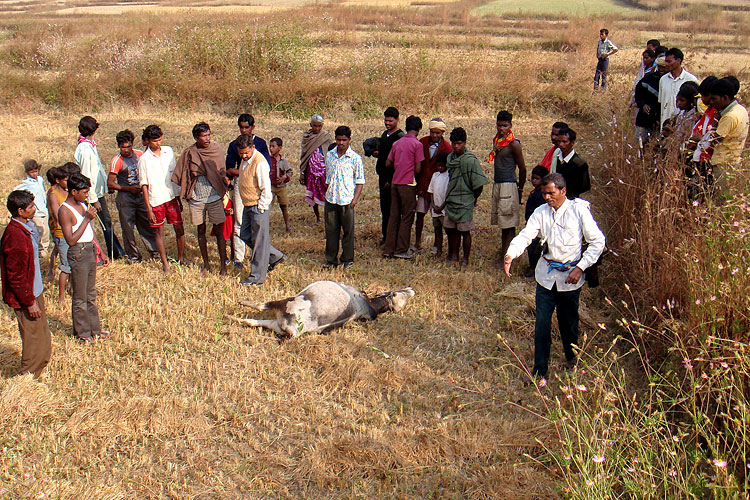Human-wildlife conflicts are among the most pressing conservation challenges today. Krithi K. Karanth, Arjun M. Gopalaswamy, Ruth DeFries and Natasha Ballal survey 735 households in a 5000 sq km area around Kanha National Park to model and map conflict hotspots and compensation access reported by people. These are highlights of their study from a paper published in the journal PloS One.
- Surveys and interviews with 735 local residents from 347 villages surrounding Kanha.
- Crop loss was reported by 73% of households and associated with cropping months and proximity to the park.
- Livestock loss reported by 13% of households and was associated with grazing animals inside the park and proximity to the park.
- Mitigation measures tried were largely ineffective with the exception of physical structures protecting livestock.
- People were more likely to be compensated if they were located in the buffer and reported incidents to authorities.
- Spatial models and maps identify conflict prone areas and villages around Kanha to target conservation action.
Study sites
Kanha National Park and the 5154 sq km landscape surrounding the reserve.
Methods
In 2011 interviews were conducted with 735 households living within 20 km of Kanha.
Results
- Crop loss reported by 73% of households and 17 species were classified as raiders with the most problematic being pig, chital and langur.
- Livestock loss was reported by 13% of households and 10 species were classified as predators with the most problematic being jackal, wolf, leopard and tiger.
- Overall, crop loss was much higher than livestock loss but both were associated with proximity to park suggesting that households closer to the park are more vulnerable.
- Households growing crops for longer time in a year were more vulnerable and those grazing livestock inside the park were more vulnerable.
- Human injury or death was reported by less than 8% of households.
- The most common mitigation measures used were night watching and scare devices for crops and closer watch on animals and physical structures to protect livestock.
- Although several mitigation measures (fencing, lighting, guard animal etc.) were tried only physical structures to protect livestock appear to lower losses. This suggests that investments in mitigation measures have to be critically evaluated.
- Fewer households (26% and 34%) reported crop and livestock losses to authorities and even fewer (22% and 41%) of reporting households received compensation. Compensation amounts ranged between $20-100.
- Unlike other Indian parks, Kanha has a legal buffer. We find that households located in the buffer are more likely to more likely to report and receive compensation.
- Injury and death to humans was reported to be very low (<1%).
- Spatial maps clearly depict higher conflict prone areas for both crop and livestock loss and identify most vulnerable villages around Kanha.
Improving Prevention and Compensation
Our approach collects spatially rigorous data from 347 villages in a large 5000+ sq km area surrounding Kanha. Our maps identify priority areas and villages where greater conservation action should be targeted. Our results suggest that crop loss and livestock loss are common but not often reported to authorities. We find that most mitigation measures are not effective in reducing vulnerability to either crop or livestock loss. For conservation investments and actions to be effective, we need to improve and evaluate the effectiveness of mitigation measures currently used. Compensation for losses goes a long way in fostering tolerance towards wildlife and enabling people to cope with these losses. Therefore, supporting people in their efforts to reporting losses to authorities and speeding the process to deliver compensation are two key steps that will aid conservation. We find that households in the buffer are better at reporting and better compensated than those outside the buffer. Currently, in India there is a massive effort to establish such ecologically sensitive zones and buffers around several parks. This has come under backlash due to political reasons and our results suggest that such buffers and ecological zones will help both people and wildlife.
This paper is freely accessible at PLoS One.
Citation Information
Karanth, K. K., Gopalaswamy, A. M., Defries, R, Ballal, N. 2012. Assessing Patterns of Human-Wildlife Conflicts and Compensation Around a Central Indian Protected Area. PloS One 7(12): e50433.


 CI is a non-profit, non-commercial portal that aims to facilitate wildlife and nature conservation by providing reliable information and the tools needed to campaign effectively.
CI is a non-profit, non-commercial portal that aims to facilitate wildlife and nature conservation by providing reliable information and the tools needed to campaign effectively.